#Kuo-Toa
Explore tagged Tumblr posts
Text
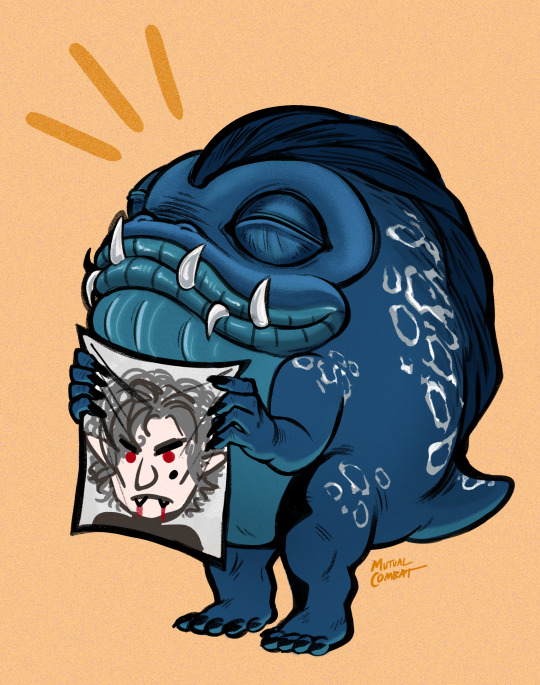
did you guys know that Beans is really good at drawing
#i just wanted to draw him nakie#hes a kuo-toa he can be a nakie fish boy if he wants to#dnd#dnd oc#kuo-toa#dhampir#my art#bg3 oc#bg3#astarion#astarion having a meltdown over how big beans drew his mole
73 notes
·
View notes
Text

Deep in the Underdark in Sloopdilmonpolop, the City of Pools, Va-Poolgol Dagagoorg the mad high priest/king tends the kuo-toa's Sacred Pool of the Sea Mother, Blibdoolpoolp, under the protection of Gapolploorg the commander of the priest/thieves and Oorg-Poolgoop Gibupgagool the priest-duke of war. (Michael Collins, Drizzt Do'Urden's Guide to the Underdark by Eric L Boyd, TSR, 1999)
#D&D#Dungeons & Dragons#Michael Collins#Underdark#Kuo Toa#Blibdoolpoolp#dnd#Drizzt Do'Urden's Guide to the Underdark#AD&D#Eric Boyd#Eric L Boyd#AD&D 2e#D&D 2e#kuo-toa#gogglers#men-fish#fishmen#fishfolk#TSR#Dungeons and Dragons#1990s#Sloopdilmonpolop
128 notes
·
View notes
Text
act 1 thingies now that I'm FINALLY getting closer to act 2 with my Durge Run :,) (pt. 1/2) (pt. 2/2 link)

-----------------------





-----------------------



-----------------------



-----------------------
lots of emotions going around, mostly about the Underdark still being my n°1 map in the whole game.

#not only are the views amazing#hard to beat the mushroom and fish people#Mahkloompah#bg3#baldur's gate 3#bg3 shitpost#kore#dragonborn#durge#dark urges#act 1#underdark#kuo-toa#gale#karlach#wyll#shadowheart#myconid
21 notes
·
View notes
Text
So apparently there’s a mod that lets you play as a kuo-toa in BG3. Once the sex scenes got brought up this image flashed in my head.

27 notes
·
View notes
Text
I'm feeling the urge to write some kind of absurdity where Raphael and Pooldripp (the Kuo-Toa) get freaky-friday'd.
#Maaaaaybe for some side story of Plots & Prosody?#Andrew voices both#mrfancyfoot#raphael the cambion#bg3 raphael#baldur's gate 3 fanfic#Pooldripp#kuo-toa#the cogs are turning#how Mephisto should really torture Raphael if he's defeated
7 notes
·
View notes
Text
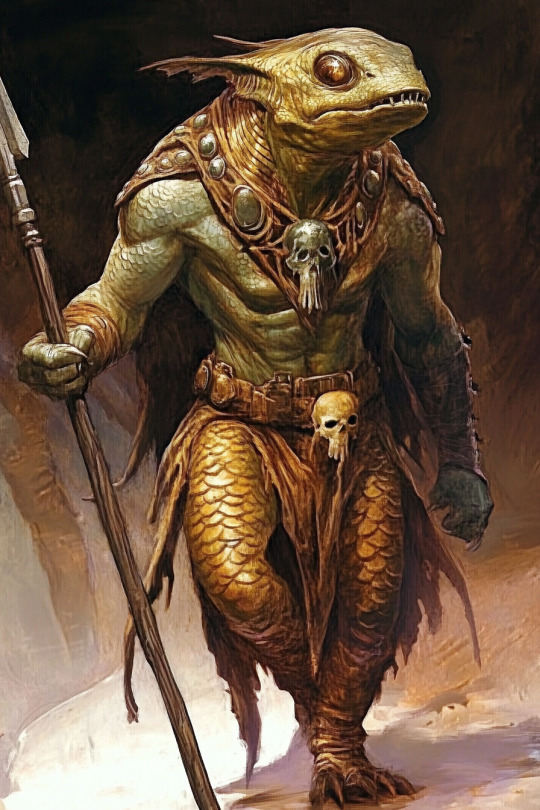
It's a fishman—a member of the fishfolk. They dwell in out-of-the-way places in Asdar, generally avoiding humans.
by Midjourney v6
13 notes
·
View notes
Text
Praise Mahkloompah!! Mack'Rel is reunited with their people at last.
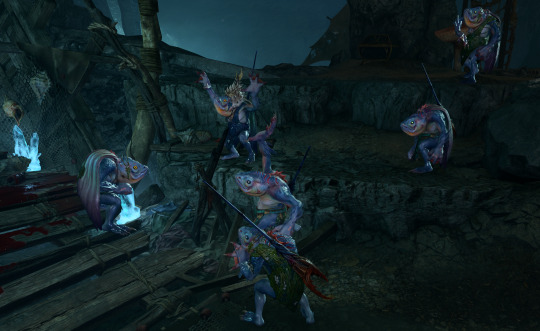
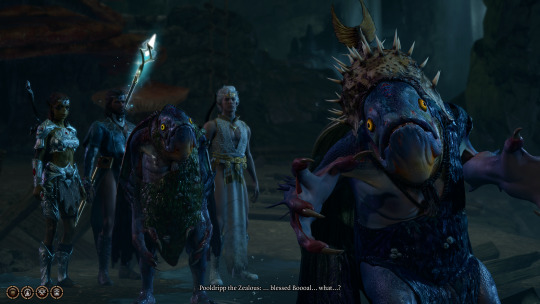
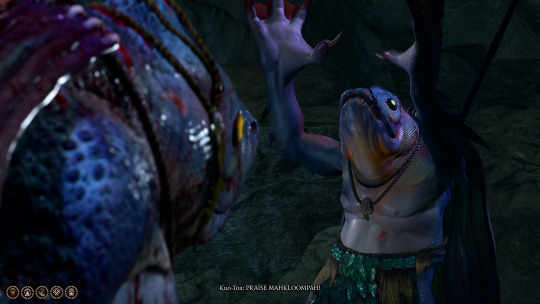
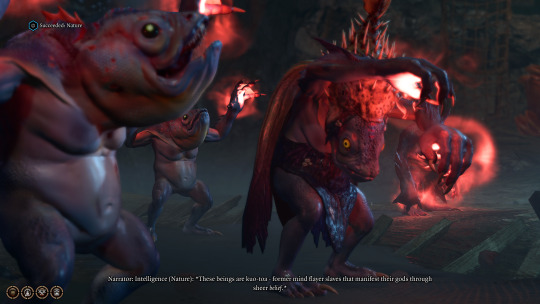
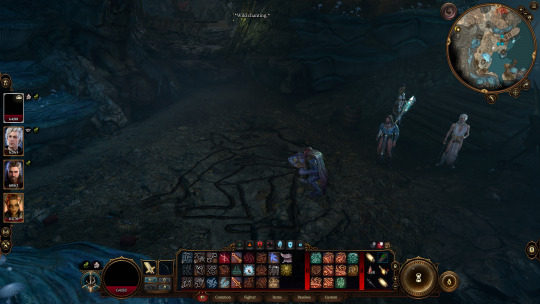
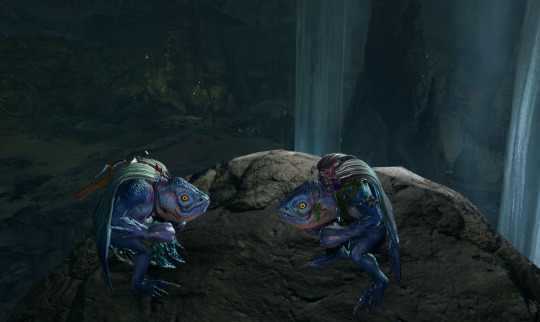
#bg3#mack'rel#baldurs gate 3#kuo toa#mahkloompah#baldur's gate#baldur's gate iii#baldurs gate#baldurs gate iii#baldur's gate 3#gale#astarion#lae'zel#fish tav#praise Mahkloompah!#kuo-toa#kuo toa tav#boooal#Booal the false god#underdark
20 notes
·
View notes
Text
Sunken
Salazar ducked behind a bend in this cave and readied himself.
He had been in this cavern for hours and it was looking more and more dire by the moment.
It was meant to be a simple job, clear out a sunken ship and pull out whatever scrap he could find, but as usual his curiosity had gotten the better of him and now he was stuck in this underwater cave. Its entrance had been covered by the ship's hull, however he’d managed to pry the metal plating off and squeeze into the cave's entrance. His diving suit had not helped, but thankfully the helm of his suit had managed to just barely fit into the mouth of the cave.
When he had gotten into the cavern proper he had figured he’d just look around for a little while then get out but that was now impossible due to the Kuo-Toa who seemed to be taking refuge in this cave. He had managed to slaughter a good few of them, with great difficulty mind you he only had a harpoon and a small knife he had ‘borrowed’ from 1 of the bodies.
His brief respite ended when he heard the wet squelching of several Kuo-Toa approaching him. He took a breath, then as 1 turned the corner he rammed his harpoon into its soft skull, its flesh rippling as the blade pierced its forehead. In 1 fluid motion he then kicked the remains of the fishman off of his harpoon and into its comrades as he rushed forward, slamming the side of the weapon into a now stunned Kuo-Toa, knocking it out.
The largest of the Kuo-Toa, brandishing a large serrated fishing spear and net, threw the net at Salazar and managed to ensnare him and then rushed forward, spear at the ready. Salazar then barely managed to drop, the considerable weight of his suit being used to his advantage as he ducked under the swing, then using his knife he slashed the net open, letting him in one motion ram the butt of his harpoon into the creatures chin and slash at its throat with his blade letting spray of blackish blood float in the water around them.
Using the blood and new corpse as a bit of cover, Salazar then threw his harpoon at the last fishman with all his might, it thankfully catching the man (woman? Hard to say) off guard as it went straight through its eye and out the back of its skull.
Salazar took a breath as he sat for a moment, catching his breath. He’d never thought of himself as much of a fighter but it would seem he was rather adept at combat even despite the considerable handicap of his suit. He’d decided to keep it on, sure it slowed him down rather significantly but it was still armour and in a pinch he’d need it, besides the saltwater stung his skin and eyes. He’d be able to breathe in it sure, but that did not change the fact that it’d be very uncomfortable.
He stood up and collected his harpoon from the head of the Kuo-Toa who’d briefly become its sheath. He then pressed on down this cave hall, making sure he was listening for any sign of Kuo-Toa. While he did not hear any Kuo-Toa themselves,he did see several markings on the walls of the cave which he deduced were Kuo-Toan writing. He unfortunately did not speak Kuo-Toa so he wouldn't be able to glean its meaning but it did display an arrow pointing further into the cave. He decided to follow the arrow, at worst he’d find more Kuo-Toa but at best it might lead to an exit.
As he approached the cavern, he began to hear something eerie, a low chanting in an indecipherable tongue, most definitely not Kuo-Toa, it didn’t have any of the characteristic clicks and blubs no this was deeper more….ancient. Despite his trepidation he felt a strange compulsion…a compulsion to press on, one that he could not shake.
The chanting got louder and louder with each step until it was all he could hear, not noticing as an inky fog filled the halls as he approached entering into a large chamber. Held within this chamber was what had to be hundreds of Kuo-Toa chanting an incantation and at the center of the room was a large obelisk, coal black with fleshy veins pulsating along its length. As he turned away to leave he found he could not look away from the piller, seemingly transfixed on it, in the back of his head he heard a voice, booming and deep.
“Come closer youngling….”
He froze, unable to retreat, he gulped pushing down a bit of vomit and slowly began to step closer to the piller, which seemed to shift and pulsate as he approached.
As he approached further the fog began to encircle him suddenly as if pulled to the ground he fell to his knees as an unearthly chorus reverberated around him, and as it reverberated he began to understand the chanting's meaning.
“Come now take the step…..Don’t look back there's nothing left…Souls are bound, hearts are gone…. Now fall before Lwyn’thorahn!”
As the incantation was complete, the Kuo-Toa plunged blades into their hearts ripping them out, as they did this the obelisk glew a crimson red. Suddenly the fog coalesced into large tendrils which enveloped his suit, ripping into it, and tearing the glass off the front of his helmet, the tendrils filling his mouth and eyes with a blackish tar which melted the skin and flesh.
Everything went dark as he screamed in agony. Wishing and hoping for death he heard 1 voice in his mind
“Death is not what awaits you young one” a familiar sounding voice echoed in his mind
He looked around and felt weightless as he could see the world outside him as if it were a movie on a screen. He saw the red stained water and the bodies of the Kuo-Toa cultists floating up towards the cave ceiling, the obelisk still glowing.
“You will prove to be very useful to me youngling…..You shall be my avatar, and the architect of my new form”
Salazar watched in horror as he saw the glass window on his suit open up and dark tendrils flow out of it, grabbing the bodies one by one and consuming them as the bloodied waters flowed into his helmet like a vortex.
“Your flesh will prove to be a powerful asset in constructing my new form, and your soul will be another one on the pile, now goodbye”
Salazar felt as his spectral form was engulfed by what felt like crashing waves and all he could let out was 1 final scream as he was dragged into the depths of the abyss, his body was not his own anymore, and while he was not remarkable, his body would be the arbiter of a new age.
2 notes
·
View notes
Text
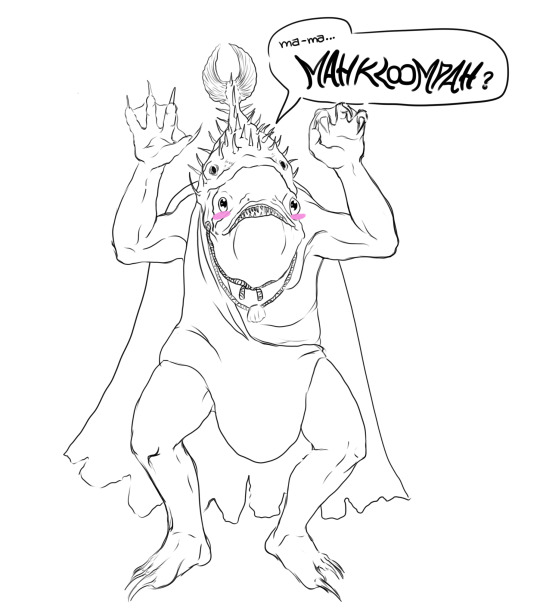
Haven’t even finished act I of BG3 and already have a fave npc, nobody can surpass Pooldripp, the Zealous in my heart, I’m so sorry Dammon
29 notes
·
View notes
Text
All my dreams are coming true.

4 notes
·
View notes
Text
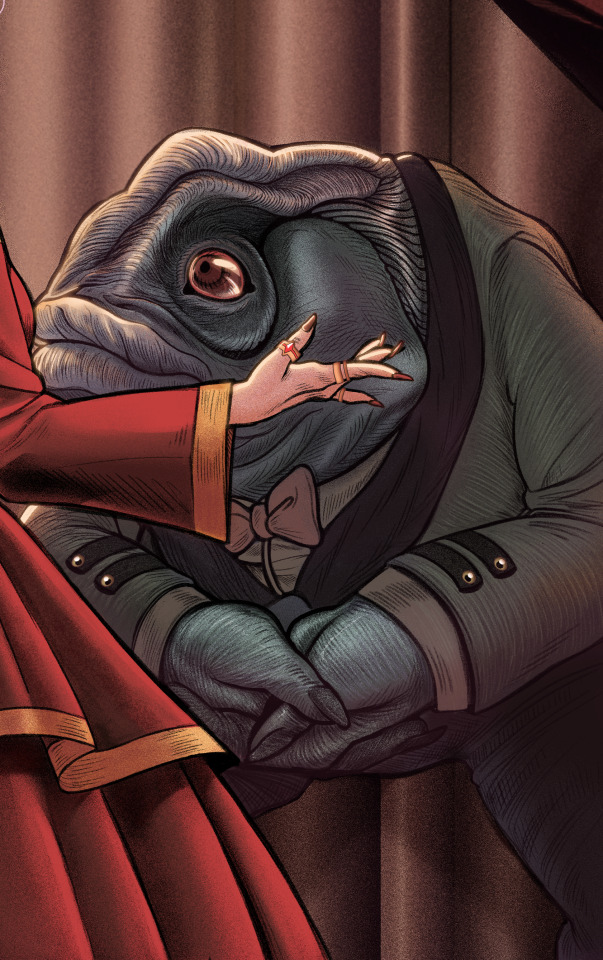
mods are asleep... post Beans
#no one understands my artist woes better than beans#beans is getting introduced in MIWI soon and im so excited#dnd oc#kuo toa#Beendelblipp#beans!#kuo toa oc#kuo-toa#bg3#dhampir#my art#bg3 oc#balders gate 3
33 notes
·
View notes
Text

The party negotiates with Duke Alooploopo of the kuo-toa (Jim Holloway, from AD&D Underdark adventure "Shards of the Day" by Randy Maxwell, Dungeon 60, July/August 1996)
#D&D#Dungeons & Dragons#Jim Holloway#kuo toa#Underdark#dnd#Dungeon magazine#dungeon#adventuring party#Shards of the Day#Randy Maxwell#AD&D#D&D 2e#AD&D 2e#TSR#1990s#Dungeons and Dragons#kuo-toa
79 notes
·
View notes
Text

Kuo-toa (pronounced: /kuːoʊˈtoʊɑː/ koo-o-TO-a), (meaning "original masters" in their native tongue) also known as gogglers and men-fish, were a debased, piscine race of warm-blooded and amphibious creatures that dwelt in the Underdark. Sinister secrets lurked below the surface of their alien minds, for the kuo-toa were fanatics plagued by mental instability that saw things others couldn't and worshiped gods that didn't exist — at least until they believed hard enough.
“They invent their own gods… The very definition of insanity." — Sabal Mizzrym of Menzoberranzan
Kuo-toa were normally 5 feet (1.5 meters) tall and weighed approximately 160 pounds (73 kilograms). Contrasting with their paunchy shape were their arms and legs, slender and lithe despite their relative shortness. At the end of each limb were broad, distended and partially webbed hands and feet. Each extremity had three main digits and one opposing digit at its end. Topping their bodies were bullet-shaped, piscine heads hosting a mouthful of sharp teeth and a pair of bulging silver-black eyes capable of independently swiveling to observe a situation.
Their bodies were covered in gray scales with yellowish undertones in males, which could vary in pigmentation based on their emotional state, such as a dark red when angered and a ghostly white when terrified. Coating their rubbery skin and piscine scales was a layer of slippery slime that gave their bodies a glimmering sheen. Normally the only clothing that they wore were leather straps to hold their gear since their slime made conventional armor and leather highly uncomfortable although some donned armor made of seashells. They did have a fondness for accessories of bone, shell, and gems. A light stench of rotten fish was constantly exuded by their bodies.
Kuo-toa were extremely suspicious, as well as duplicitous, betraying trust for their own benefit so long as they believed they could do it successfully. They were easily willing to turn in family members they suspected of crimes to community officials, and as such were normally perceived as cruel monsters by most other races, but this wasn't entirely accurate.
The mental oppression they suffered at the hands of other races broke the already-simple minds of most kuo-toa and as a result madness was a common ailment amongst their kind. Kuo-toa were not all necessarily evil, but within their repressive theocracy, common kuo-toa did not possess anywhere near enough willpower to oppose the ruling castes.
While the bloodthirsty rulers of their kind commonly fit the loathsome image their kind invoked, (with around 40-50% of the race being neutral evil) the silent majority of them lacked the same cruel zeal, conforming to peer pressure and fear of abuse more than anything else. These common kuo-toa were more neutral than the nobility (some occasionally being good), and when separated from these societies, kuo-toa could adopt philosophies such as pacifism.
Kuo-toa were an amphibious race, capable of operating with equal or greater mobility underwater as they could on land. The slime produced by their skin was also fairly useful, partially protecting them from poisons and allowing them to wriggle free of most attempts to restrain them. The kuo-toa possessed incredible monocular vision capable of perceiving invisible or even ethereal creatures when they moved, although their time in the Underdark rendered it poor aboveground.
The psychic damage inflicted by the illithids rendered the kuo-toa mad, but had another, unintended side-effect. In their insane state, the kuo-toa invented gods of their own to protect themselves from the threats they constantly faced. The subconscious energy of belief of enough kuo-toa simultaneously was actually capable of causing the entity to manifest in reality. This subconscious power allowed the kuo-toa to draw power from their own belief in said entity, giving them access to a kind of divine power. The more powerful the gogglers' belief, the greater their abilities, with some individual priests being capable of causing supernatural events. Two priests working in concert could achieve effects like creating blasts of lightning.
A dangerous ability the kuo-toa possessed was the contagious nature of their madness. Possibly owing to their mental abilities or simply their weak wills, the initial break of a kuo-toa's mind had a 10% chance of causing other gogglers around them to suffer from similar episodes. Even though madness contracted this way was confined to temporary breaks in anyone but the first victim, this was still a very dangerous phenomenon. If not culled or detained quickly, the madness could swiftly infest the entire community, sending it spiraling into chaos, not to mention potentially freeing slaves and killing important leaders.
Kuo-toa combatants without access to divine abilities had to make use of martial skill and cunning to be effective warriors. Commonly, these types of kuo-toa were martial artists or rogues that employed such tactics as drowning unsuspecting enemies, quick movements with knives to incapacitate, applying adhesive to their blows, and other nasty tricks.[ Even many priests would incorporate some regular combat training into their regimen in order to better do battle.
While capable of biting their opponents, they more typically employed weapons like spears and shields against their foes. Because of their use of slave labor, they commonly employed nets, harpoons, and pincer staves in order to capture their enemies. They could also secrete an adhesive oil, which they applied to their shields, causing weapons that struck them to become stuck.
Society Kuo-toa societies were oppressive feudal theocracies ruled by a Vi-Poolgol, which translated to "priest-king", and nine Oorg-Poolgoopan, also known as "priest-dukes". The priest-dukes formed a religious governing body known as the Sunken Council, which exercised complete control over the citizens' lives. Each council member dictated a different element of kuo-toa society, with dukes for fishing, trade, war, agriculture, mining, pilgrimage, sacred sites, slavery, and child-rearing. While the king and dukes theoretically held absolute authority over their subjects, the kuo-toan propensity for madness forced noble elites to forge alliances with other elites to mitigate infighting. Directly below the priest-dukes were the Ba-Poolgol, priest-princes who might rule over smaller cities. Some kuo-toan elites possessed concubines, who were indolent members of the opposite gender.
Serving under the kuo-toan nobility were the Vi-Plagoop and the Ba-Plagoop, inquisitor rogues and normal priests known as the Eyes of the Priest-King and Pincers of the Priest-King, respectively. Handling sacrifices were a lesser caste of priests known as lashes, who specialized in lightning abilities. Enforcing the authority of the Sunken Council upon the fragmented kuo-toa communities were the Va-Scour, otherwise known as whips, fanatics who inspired the kuo-toan militia to fight fervently for the archpriests and their gods. Their power was bestowed on them by archpriests rather than their own belief energy. Whips were normally only the children of archpriests, and would fight to the death for the honor of taking his place after his expiration, although whips who displeased their masters could be stripped of their divine power and even killed.
Blib-sanvu, more commonly known as monitors, were an order of celibate, elite warrior-monks who acted as the secret police of kuo-toan society, whose duties involved the culling of the weak as well as the killing and subduing of the criminal and insane. The monitors practiced a special kuo-toan type of martial art that involved the exercise of mental control and channeling their inner madness through their fists and into their opponents. Other techniques applied by monitors included the smearing of adhesive with their strikes and lunging with abnormal speed for a kuo-toa. Both whips and monitors underwent heavy mental exercise to reduce their capacity for madness.
Whips and monitors were assisted by elite warriors called harpooners, whose job it was to assist in the capture and confinement of crazed citizens using their harpoons, although they were just as capable of using them to fight invaders. Other warriors included cutters and drowners, kuo-toa rogues who used subterfuge and secrecy to do combat and who typically served purely offensive roles in the hierarchy. Kuo-toa who succumbed to madness were captured, with violent ones exiled to regions outside of a settlement to act as a first line of defense, or ushered inside holding cells built into walls of defensive positions to act as disposable shock troops. There also existed kuo-toa marauders, those with slight taints of madness who hunted the Underdark for creatures to enslave and sacrifice.
Common kuo-toa performed menial labor, such as fishing, farming, or guard duty, although without supervision by a whip or monitor they would normally flee dangerous combat situations. Gogglers were excellent fishermen, capable of diving deep to collect mollusks, crustaceans, and fish from the depths of their pools. Although a diet of flesh was preferable, they were equally capable of living off of plant matter and would create fields of mushrooms and kelp lit by phosphorescent fungi that were tended to by slaves. Due to their poor mining skills, they would employ slave labor in order to conduct mining operations. While they possessed a mild fondness of gemstones, they much preferred sacred relics, shells, or pearls, and would gladly trade the former to obtain any of the latter.
Within the rigid caste system of the gogglers, those of higher status were fanatically fawned over while inferiors were treated like slaves. Even fingerlings felt the bindings of the caste system, with normally only noble spawn becoming priests or monitors, and young ones grouped in pens sorted by gender, fitness, and nobility. However, kuo-toa society was also extremely meritocratic, with skill being a major determinant in an individual's place. Although the ability to rise and fall existed, superiority itself gave individuals the right to lord over others, which was where its true rigidity laid. It was common for kuo-toa to plot against their superiors in order to gain an edge against them, even planning to kill them, although the monitors usually kept the latter from happening.
The primary flaw in their system was a combination of the kuo-toa's own propensity towards insanity and the structure of the justice system. Because the system was designed not to remove those unfit for power, nobility suffering from madness of their own would retain their positions, forcing monitors to apply interpretation to their teachings, with some monitors becoming inefficient themselves because of their own mental disorders.
Architecture Kuo-toa communities were centered around pools used for a wide range of activities including recreation, transportation, religious offerings, exercise, eating, spawning, and fingerling care. They were believed to be highly traditional areas, hearkening back to their past presence in aboveground tidal pools and were occasionally covered by glass domes. Kuo-toan nobility commonly possessed private royal spawning pits, where only they, their concubines, and kuo-toa above them could enter. There also existed noble fingerling pools, in which pampered young were brought their food.
All Blibdoolpoolp-worshiping communities contained shrines, with larger communities holding major temples that served as hubs for smaller, primitive settlement clusters radiating out from them. Most kuo-toa lived in small tribes far from their ancestral homes, and would make great pilgrimages to reach the temples. The shrines were often in damp caverns surrounded by great bodies of water and welcomed all kuo-toa as well as other races, serving as forums for inter-group trading, council meetings, neutral zones, and Sea Mother worship. Although communities were usually not cooperative they would band together to defend such spots from destruction. Within the Underdark lay a sacred shrine known as the Holy Mother's Cauldron that every kuo-toa aimed to visit at least once in their lifetime. Other large ziggurats were normally constructed within shallow pools encircled by stones that served the dual purpose of staircases and amphitheaters from which the adults could watch and conduct unholy rituals.
Kuo-toan architecture was one of the few areas not heavily monitored by the ruling clergy. It retained marine elements, with blue and green gems as well as shells embedded in objects being primary focuses and artisans working endlessly to imitate alien thought patterns into their shell-like patterns. It was rumored that those who looked at kuo-toan architecture for too long and hard would succumb to madness. Home decorations also included beds of seaweed and silken cloths. There were few freestanding buildings, as the central caverns served as market, communal area, and places of worship, with individual residences simply being carved into preexisting walls. Apartment systems existed for pilgrims to take refuge in after long journeys. Sea mother statues were a common sight, often placed on top of temples built by other races. Throughout the shrines were various icons, carvings, and other artistic works made to venerate the Sea Mother.
Religion Kuo-toa societies were almost all based around the worship of Blibdoolpoolp. While earlier reports describe her as an ancient, eldritch deity, more recent ones believe her to be a figment of the gogglers' imagination given divine form. Either way, the diligence of Blibdoolpoolp's whips made her the dominant deity among all other kuo-toa and the focus of the kuo-toas' lives. She even created her own chosen out of gifted whips and monitors, monsters known as kuo-toa leviathans.
Blibdoolpoolp's priests conducted constant sacrifices in her name in ceremonial drowning pools, usually choosing of captives and slaves, although kuo-toa perceived to be mad or defiant could also be sacrificed. The duties of the archpriests involved communication with outsiders, judging criminals, conducted rituals during breeding seasons, and the growth/culling of fingerlings.
Other Gods The ruling archpriests of a kuo-toa community decided which gods the lower kuo-toa had to exclusively worship some of which were imagined by the priests themselves. Kuo-toa might also revere krakens, aboleths, morkoths, and other eldritch horrors, with their madness having blinded them to their manipulation by said entities Some tribes followed more conventionally divine entities, including the slimy and eldritch Ghaunadaur, tyrannical Bane, the water deity Istishia, and the mistress of darkness Shar.
Some kuo-toa tribes also engaged in demon worship, venerating such beings as the brutal Demogorgon. Demogorgon’s kuo-toan followers exulted in mindless acts of violence, and tried to appeal to him so he would aid them in the restoration of their empire.
The nearly-extinct kuo-toa of the open seas, mostly wiped out by sahuagin that rightly viewed them as a threat, were the most fanatical followers of Dagon. They believed themselves to be the primal race, and that Dagon would one day return to flood the land of the surface-worlders. They also spread his faith to humanoids, small bands of their cults infiltrating desperate and ignorant coastal towns of the world. Allegiance was rewarded with gold and fine fishing, and resistance punished with genocidal raids.
The kuo-toa sent as ambassadors to these surface towns were invariably the "Voices of Dagon", members of the community who (unlike the respected yet feared clerics of Dagon) were not only trusted to preach the word of Dagon, but to retain the best interests of the kuo-toa race at heart. Often they were given gold statuettes and jewelry to bribe and sway the more manipulative and greedy. Only the most talented of deep-dwelling kuo-toa bards, often selected from the pool of charismatic children chosen to train as bards, had the honor of receiving the post.
Sometimes kuo-toa worshiped existing deities under unusual names; they might call Demogorgon "Leemooggoogoon", or refer to Bhaal as "BOOOAL".
Relations Kuo-toa were antagonistic to almost every other subterranean race and all surface-dwellers. They had no qualms about kidnapping others and sacrificing them to their gods or using them as slave labor, with one-quarter of their population comprising slaves. They had a special enmity with the drow, who had exterminated them on sight at one point in their history. Despite hating and fearing the drow, the dark elves were among the kuo-toa's most common trading partners, and they would even cooperate to raid deep gnome settlements and capture them for sacrifice. This partnership was strictly business and the two would still hold minor skirmishes and would capture each other's people.
Kuo-toa recognized the need for trade and would conduct it with practically any race, the exception being the mind flayers and their allies, who were invariably attacked without warning. This was most likely due to the mental oppression inflicted upon the kuo-toa by the mind flayers that crippled the remains of their once mighty empire. Among the few races kuo-toans freely associated with were ixzan, whose respective deities had good relations. Within the kuo-toan cities, ixzans lived separately from the men-fish.
In centuries past, before the abandonment of wizardly pursuits to the power of religious institutions, kuo-toan clerics and arcane masters worked together to create titanic siege crabs to lay waste to their enemies. Other mounts utilized by the kuo-toa included a rare species of giant sea slug known as seryulin and even willing morkoth.
Ecology Similar to how normal fish spawned, females would lay eggs in the communal pools that were later fertilized by the males. Young kuo-toa, known as fingerlings, resembled a cross between tadpoles and fish. They were a foot tall and entirely aquatic, living in the pools for a year before they grew to about three feet tall and became fully amphibious. These older fingerlings were raised in separate pens based on various factors until reaching five years old and becoming full-grown adults.
When kuo-toa reached semi-maturity, culling rituals would take place in order to reduce the large number of them that were spawned. Amongst these rituals was an underwater maze filled with ixzan that would weed out weak, slow, and gentle fingerlings. Fingerlings were generally not treated as individuals until they'd survived to adulthood. Kuo-toa lived to be approximately sixty years old. When Blibdoolpoolp wished it, a single kuo-toan egg would give rise to an exalted kuo-toa, mentally and physically powerful gogglers who would quickly ascend the hierarchy as whips.
Kuo-toa were capable of interbreeding with humans to produce offspring physically similar enough to infiltrate human society. Offspring could also appear normal at birth, but graudually take on kuo-toa shape more and more as they aged.
History Kuo-toan history was difficult to compile as the race had existed long before human recordings, although various legends suggested that they were distant relatives of the locathahs and morkoths. One theory as to their origin that was widely embraced by many scholars in Faerûn as a "fact", but largely dismissed by the scholars of Serôs, suggested that all three had a common ancestral race that was created through a magical fusion of fish and human slaves for the purposes of gathering food and treasures beneath the sea. Who exactly was responsible for their creation varied significantly, with suggested identities for the creators ranging the gamut of dragons, the Imaskar Empire, the Netherese Empire, the God-Kings of the Old Empires, or in someway all of them. This common ancestor was said to have dived deep into the depths of the Inner Sea where they discovered a group of dark gods that promised them power and freedom from those who subjugated them in return for worship. Some legends suggested that this occurred in the Trench of Lopok. The dark gods were then said to have transformed these ancestral fishmen into the first kuo-toans and morkoths, though some variations of the story claimed that ixitxachitls and selkies were also created from this.
Another theory suggested that they were descended from or creations of the Batrachi.
Beyond their initial creation, some legends spoke of ancient kuo-toans establishing an empire on the surface, before being driven back by humans and demihumans. Others thought that land-dwelling, but sea-modified races like the sea elves drove them to near extinction and toppled their underwater empire. It was likely that both were true, with man-kind's growing power and numerous surface world allies wiping out the initial invasion and those that sought refuge in the seas being killed by the various monsters that swam within it. Notably, there existed certain ancient kuo-toa tribes that dwelt in the open depths of the ocean who had never heard of Blibdoolpoolp. This was of particular note, given theories in the Present Age that the kuo-toa invented deities after being mentally broken to protect themselves from a hostile world.
In recorded history, by the end of the Second Serôs War beneath the Inner Sea in −8212 TS (−8282 DR), the Kuo-Toan Consortiums had been wiped out. On the Plains of Duna, their cavern cities all collapsed and the kuo-toa there were slaughtered. This genocide left them still practically extinct in the Inner Sea until the 14th century DR. Some of the kuo-toa of the Inner Sea fled to the depths surrounding the Aglarondan Peninsula, while others fled through the the Tunnels of Iratis and eventually founded the city of Leshnymul.
Either way, the kuo-toa were forced to reside in Underdark caverns and continue their empire within its murky depths. The kuo-toan version of this tale had the gogglers leave their ancestral domains. During this migration, the gogglers encountered something that drove most of their race mad. By some accounts it was the mental domineering illithids, who enslaved and mentally mangled the minds of the kuo-toa race. With the race rendered useless as servants for their lack of sanity, the illithids abandoned them,and it was for that reason kuo-toa would kill them on sight.
Other reasons for the widespread madness of the kuo-toa included mental domination by other eldritch monsters, such as enslavement by morkoths, genetic degradation due to inbreeding, the dark rituals made to their mad gods, the mental strain caused by constant suspicion and brutality, and the spread of insanity like a disease in their communities. A similar racial hatred existed between the gogglers and the drow, although mitigated by the drow's possession of useful trade goods. It was theorized by many that one of the primary reasons that neither of the three races had attempted a large-scale invasion of the unsuspecting surface was that they were locked in constant battle against one another.
Their empires entered a state of decline and only a few of their once great cities remained with other kuo-toa forced into hiding in small underground oases. Some of their cities were Sloopdilmonpolp, the City of Pools; Looblishar, the City of Welcome Darkness; and the magocratic Arcanum of Olleth.
Notable Kuo-toa
Nogah, a one-time senior whip and a cleric of Blibdoolpoolp. She found the ancient aberrant artifact Dreamheart and attempted to start her own cult. Later she lost Dreamheart to a Kraken - Gethshemeth and was killed by aberrant kuo-toa enslaved by the magical orb.
Curampah, Nogah's second whip who aided her in their quest to discover the Dreamheart.
Shuushar the Awakened, a peaceful kuo-toa hermit. He had adopted a pacifistic philosophy and refused to fight even to defend himself.
Source: https://forgottenrealms.fandom.com/wiki/Kuo-toa
4 notes
·
View notes
Text
What now?
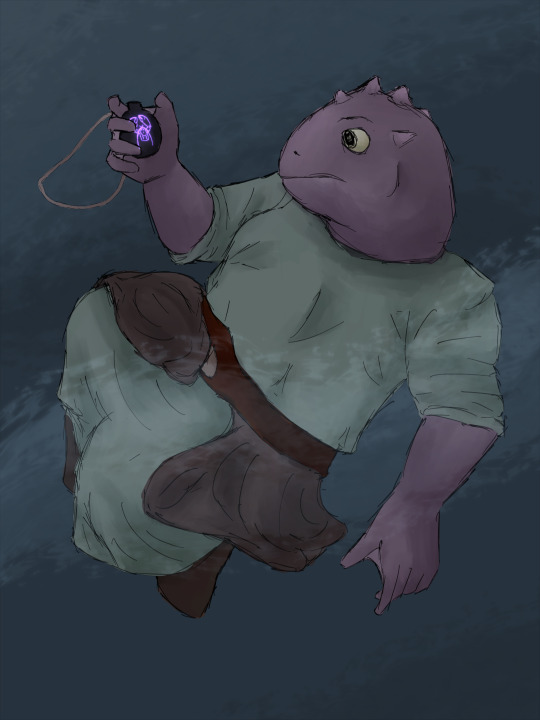
Experimenting with a couple new brushes and had to draw the fish boy hehe (I'm actually not sure I'm a fan of the brush I used for the sketch but eh maybe it just takes some getting used to kflsda)
I am very normal about Sloopidoop being an archpriest (presumably of Blibdoolpoolp) while being a founding member of the Society of Brilliance wym
6 notes
·
View notes
Text
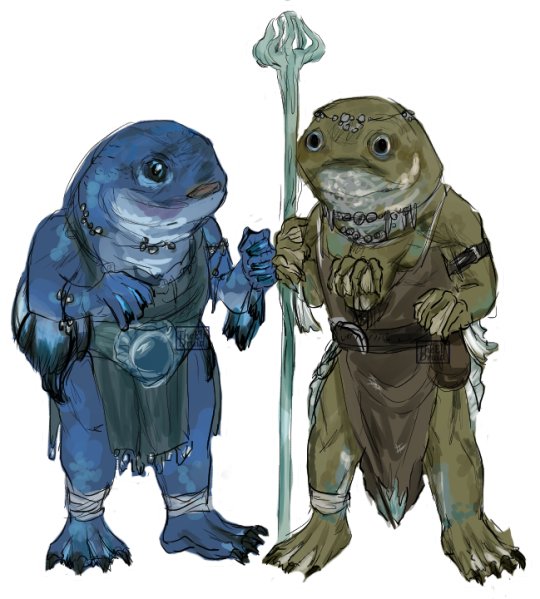
Some really quick kuo-toa I did for a mini-campaign of mine, based off my favorite horrible little fish, the Devil's Hole Pupfish (or as it's known in the campaign, the Zariel's Pit Pupfish). This is what happens when I make an entire 30 page D&D adventure based off an inside joke.
More Baldur's Gate art coming soon...
[Image ID: Two humanoid fish creatures known as kuo-toa stand beside one another. The fish on the left is an brilliant cobalt blue with white and black fins on its arms and back. It wears a short blue robe with a matching, ornamental belt, and stares sideways at the camera with a dopey expression. The fish on the right is a yellow-green color with translucent white fins, with a third arm protruding from its chest. It wears a brown smock with blue, wooden accessories, and leans slightly on a staff of the same wood. It has two human belts around the waist and one arm, alongside a belt pouch, and stares blankly at the camera. Both fish wear jewelry made of stone beads.]
6 notes
·
View notes
Text
~WIP Whenever~
Because Wednesdays are the busiest day of my weeks ^^;
Exciting things happening with Plots & Prosody! Chapter 23 will feature Raphael's reaction to finding more of the bits and things Evie left for him to find around his office. Shouldn't have left the fox unsupervised~
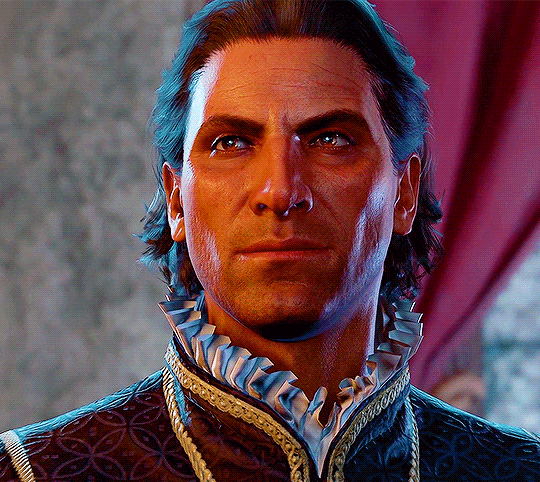
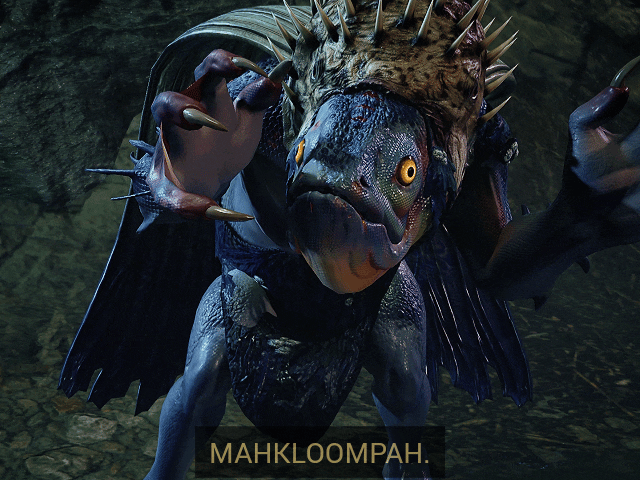
And I am working on a short side story for Prosody that will take place post-game (Raph has the crown but has not yet taken over Avernus). Raphael goes with Evie one day to check on her tribe of fishies in the Underdark, but oops, by way of a found cursed artifact that is offered to her, Raphael finds himself swapping bodies with Pooldripp, Evie's Kuo-Toa high priest. There's a way to fix it but Pooldripp's feeling a bit more confident...more dapper in this new devilish body he's found himself in. After getting a bit of a taste of the infernal power and finery now at his fingertips as an archduke of the Hells, Pooldripp's decided he doesn't wanna swap back. This new body will let him worship Evie, his glorious fluffy sunbeam, all the more devoutly!
And all the while, Raphael is having an existential crisis in the body of a Kuo-Toa. He will have to work together with Evie (who's trying so hard not to panic while secretly managing Raphael's affairs for him in the meanwhile) to get back to normal lest all of that hard work over the past millennia be for naught! His biggest saving grace is that Evie actually likes him and would prefer him to be back in his proper body. Many shenanigans ensue.
This will most likely be posted separately from Prosody on AO3, so keep an eye out! This fever dream is brought to you by my cursed knowledge that Raphael and Pooldripp are both voiced by Mr. Wincott. :]
I hope others can see my vision lmao
Ch 23 Teaser:

Raphael sat stiffly at the broad, polished table, each slip of paper arrayed before him like scattered game pieces.
He had scoured the room, frustration spurring anger each time another folded fragment had revealed itself. Yet he'd persisted, meticulously combing through the shelves, slipping fingertips between leather-bound volumes and beneath crystal paperweights—effort more commonly owed to sweeping a sensitive space for spying spells, curses, and hexes. One was nestled among a row of dense infernal contracts, another more brazenly propped against a bronze and bone hourglass. Had she counted the seconds and minutes he had left her alone? Or perhaps an invitation for him to measure out the time wasted seeking her hidden whimsies. “‘All mimsy were the borogroves,’” he muttered, his lip curling with disdain even as he felt the sharp hook of fascination catch on his flesh. Utter nonsense, surely? And yet...there was an urge to cross reference it against various lexicons to be safe. Would she embed veiled meaning into the bits of her left behind?

#plots & prosody#bg3 raphael#raphael the cambion#bg3 Pooldripp#baldur's gate 3 fanfic#raphael x tav#raphael x oc#baldur's gate 3 raphael#baldur's gate 3 raphael fanfic#Pooldripp#kuo-toa#bg3 kuo-toa#mrfancyfoot#wip whenever
5 notes
·
View notes